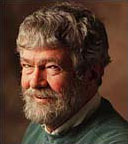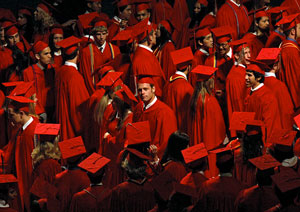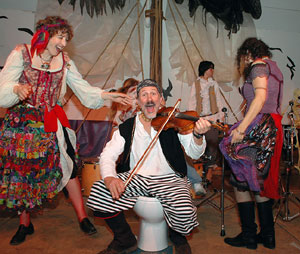 |
→ June 2004 Contents → Camera Corner
|
 | |
The Nikon D70 Digital Camera
June 2004
|
 |
|
The Nikon D70 is a pretty amazing little camera. For a relatively small price you get a whole lot of picture-taking ability.
When the D70 was first announced it was touted as an entry level Digital SLR to rival the Canon Digital Rebel. What it turns out to be is a very capable camera that can fit into any Pro shooter's bag as a second body to either the D2H or the D1X or it can be the basis for starting a serious move into digital.
I have been using the D70 with the Nikkor 17-55 F2.8 lens and the SB800 flash unit for a couple of weeks now and am more impressed each day. I think a couple of D70 bodies would be a great way to go for any photojournalist who is honest enough to say that he/she really don't need eight frames a second or that a 17 megabyte file is big enough for the kind of work that they do. It reminds me of how it was hard to convince yourself that you could take as good a picture with a Nikon N90s or F100 as you could with your F5. You can, you did and you will.
Would I like to have the 2.5 inch LCD and the huge buffer of the D2H, of course. Same as the larger file size of the D1X but, on the other hand, I sure like the fact that a pair of D70s is a thousand bucks cheaper than one body of either of those two.
What you do get is a 6.1 MP CCD image sensor that produces 3,008 X 2,000 pixel images in a camera that starts up instantly and has minimal shutter lag time. The polycarbonate body feels good in the hand and seems quite rugged in use. Underneath is a stainless-steel chassis and lens mount.
Nikon claims that you can shoot at three frames per second for a continuous burst of up to 144 pictures (using JPEG NORMAL- Large setting and a fast CF card like the San Disk 256 Ultra). Well, I don't shoot at Normal, I shoot at Fine but I do have that very same card so trying it out, I found that I could indeed keep my finger down on the shutter release button and the camera would keep firing through the whole 72 frames. It would, however, show down after 12 or 14 frames to about two a second and then to one frame per second but it would keep going. One of the reasons that it does keep going is the rechargeable lithium-ion battery system. It's the same one that is in the D100 and it can power the camera for over a 1,000 pictures per charge. The ability to set the color balance to Adobe RGB and shoot Raw (NEF) files is another Pro feature, although one would have wished that the combo mode would have allowed more than JPEG basic.
I did not have a chance to use the "kit" lens that ships with the D70. It is a 18-70mm f/3.5-4.5G ED AF-S DX Nikkor that has gotten some great reviews. The D70 body is going for $999 and the camera and lens for $1299. That translates to $300 for a 27 to 105mm lens that has a Silent Wave Motor.
My East Coast buddy, Jon Falk, who is best known for his Big Yellow Book, "Adventures in Location Lighting," recently purchased a D70 kit and he has been singing its praises to me via email. Here are some of his comments: "The 18-70 is a wicked sharp lens, rocket fast AF and great zoom range of 27mm - 105mm." Describing the camera, he adds: "You're gonna love the lack of shutter lag and the buffer speed and the instant LCD preview feature."
That said, the 17-55mm lens is also a real winner. It works out to be a 25.5-82.5mm constant F2.8 on the D70. It is tack sharp at all focal lengths and also is very quick to focus even in poor light. My only complaint is that the size of the lens and its huge and very effective lens shade blocks the output of the built-in flash when you try to use it in emergency situations. Falk says a similar problem exists with the 18-70 unless you take the lens shade off.
Getting back to the built-in flash, it is small only in size, not in features. Its built-in Manual mode with Power Ratio, from full output to 1/64 power in 1/2 stop increments, lets you fine-tune the flash in any situation. It also can be used in Commander Mode to remotely control a group of multiple wireless SB-600 and/or SB800 Speedlights. If you put an SB800 on the camera and use it as a Master you can control up to three remote groups of wireless speedlights, with each group consisting of any number of Nikon SB800 or or 600s. In short, with flash the D70 can do everything the big boys do.
"Finally, using my wide angle fixed non-zoom flash head with the white diffuser dome technique, one has to be very sure not to tilt the flash head forward. Not even one notch. This will create an unwanted low level but visible shadow being the subject, because a little bit of the fringe wide angle flash beam is getting straight out to the subject . . . like low powered direct flash. That is the end of what just occurred to me."
Following up on Jon's what-just-occurred-to-me theme and noting the lack of really detailed specifications so far, I would like to refer you to a couple of places where you can find that kind of stuff.
Thom Hogan has an excellent and extremely detailed report at: http://www.bythom.com/D70REVIEW.HTM
He lists drawbacks as well as positives but this quote seems to sum it up: "If the Digital Rebel is a crippled 10D, the D70 is an enhanced D100! Love the meter, love the flash, like the improved controls and menus, not missing much of anything (realistically, only the missing mirror pre-release is a functional thing that I miss)."
I shot most of my tests using the jpeg fine setting since that seems to be what most photojournalists are using. I made several tests using RAW and even though the D70 has a "new" NEF format, if you download the Adobe Raw 2.2 plug-in or use Nikon Capture 4.1 you will not have any problems reading the files. The ability to "touch up" the "RAW digital negative" in the computer remains unsurpassed. For a more detailed review of using the camera in the RAW format, check out Uwe Steinmueller at www.outbackphoto.com.
And we can't forget a useful tip from Rob Galbraith.
He has done extensive research in the CompactFlash Performance Database Section of his site. He has tested the cards with every major DSLR and had this to say about our subject: "The Nikon D70's method of buffering photos before writing them to the CompactFlash card means that the card's write speed directly impacts the number of frames that can be recorded in an extended sequence."
So after shooting the camera for a little less than three weeks I have made one important decision. I'm going to buy one. The only problem is that my photographer wife, who to this point has been extremely satisfied with her Olympus E10, told me today that she wants one too!
© Chick Harrity
|
|
Back to June 2004 Contents |
|
 On the ISO front, I was very impressed at the improvement in quality. Images at 200 and 400 are excellent and very hard to differentiate, 800 is good and 1600 very acceptable. The portrait of my mother-in-law was made at ISO 400 and the one of my nephew's high school graduation made at ISO 1600 in a very tricky lighting situation, the image of the Pirate fiddling at the Calistoga Education Foundation fundraiser is also at ISO 400 with a little SB800 fill thrown in. All but the Graduation picture are with the 17-55, it was made with the 70-180 macro zoom at 180 which given the 1.5 lens factor made it a 270mm.
On the ISO front, I was very impressed at the improvement in quality. Images at 200 and 400 are excellent and very hard to differentiate, 800 is good and 1600 very acceptable. The portrait of my mother-in-law was made at ISO 400 and the one of my nephew's high school graduation made at ISO 1600 in a very tricky lighting situation, the image of the Pirate fiddling at the Calistoga Education Foundation fundraiser is also at ISO 400 with a little SB800 fill thrown in. All but the Graduation picture are with the 17-55, it was made with the 70-180 macro zoom at 180 which given the 1.5 lens factor made it a 270mm. Speaking of that SB800, I have found that the balanced fill flash mode works best with the flash dialed down at least one to one and a half stops, same with the little built-in flash. The SB800 has many features for controlling multiple flashes and doing other amazing tricks and, happily, they all work with the D70. The supplied omni dome makes for nice bounce light. Another great flash feature is that Nikon has increased the synch speed to 1/500, making outdoor flash fill that much easier.
Speaking of that SB800, I have found that the balanced fill flash mode works best with the flash dialed down at least one to one and a half stops, same with the little built-in flash. The SB800 has many features for controlling multiple flashes and doing other amazing tricks and, happily, they all work with the D70. The supplied omni dome makes for nice bounce light. Another great flash feature is that Nikon has increased the synch speed to 1/500, making outdoor flash fill that much easier. My lighting guru, Falk, had this to say when I queried him on his first few days with his D70/SB800 combination: "It occurred to me that I also use that flash in the dark club at slow shutter speeds in the bounce mode by pulling the wide-angle reflector out and into place in front of the flash tube. Then I put their dome diffuser onto the flash. With the w/a lens in place over the flash and under the dome the flash output angle stays in one position - - - WIDE - - - no matter where the lens is zoomed to. I have found that zooming lenses also zoom the flash head, because these genius Nikon engineers figured the flash power can be increased for tele-shooting in a direct flash way. We rarely shoot direct flash. Also, I have discovered over time that the light quality in bounce through a dome from a flash that is zoomed to a narrow beam is less good than my way of keeping the light beam wide. I NEVER rotate the flash head to accommodate a vertical picture. The light sucks no matter what that way. Instead, if I shoot verticals I rotate the camera in the bracket, which keeps the flash in the widest bounce horizontal way. Think of it as good quality horizontal light falling on a narrower vertical subject."
My lighting guru, Falk, had this to say when I queried him on his first few days with his D70/SB800 combination: "It occurred to me that I also use that flash in the dark club at slow shutter speeds in the bounce mode by pulling the wide-angle reflector out and into place in front of the flash tube. Then I put their dome diffuser onto the flash. With the w/a lens in place over the flash and under the dome the flash output angle stays in one position - - - WIDE - - - no matter where the lens is zoomed to. I have found that zooming lenses also zoom the flash head, because these genius Nikon engineers figured the flash power can be increased for tele-shooting in a direct flash way. We rarely shoot direct flash. Also, I have discovered over time that the light quality in bounce through a dome from a flash that is zoomed to a narrow beam is less good than my way of keeping the light beam wide. I NEVER rotate the flash head to accommodate a vertical picture. The light sucks no matter what that way. Instead, if I shoot verticals I rotate the camera in the bracket, which keeps the flash in the widest bounce horizontal way. Think of it as good quality horizontal light falling on a narrower vertical subject."